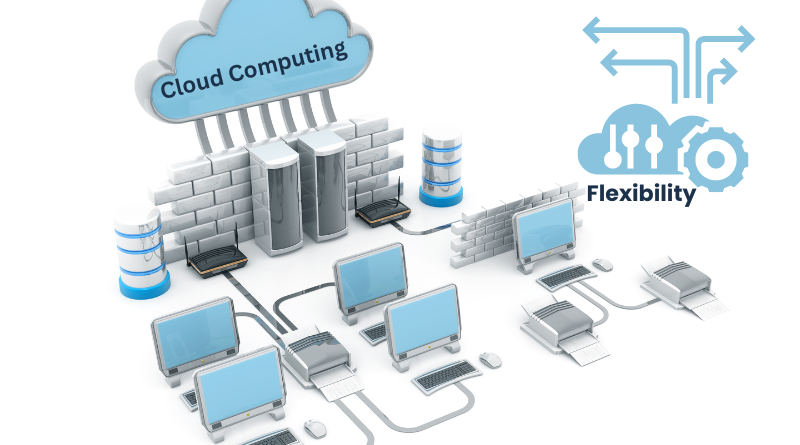Cloud computing has brought about a revolutionary transformation in the way businesses function in the modern digital era. One of the key advantages it offers is flexibility. The ability to scale resources up or down as needed allows organizations to optimize their operations and adapt to changing demands. In this article, we will explore the concept of flexibility in cloud computing and delve into its benefits for businesses of all sizes. So, let’s dive in!
Table of Contents
What is Cloud Computing?
Cloud computing refers to the delivery of computing resources, including servers, storage, databases, software, and networking, over the Internet. Instead of relying on local infrastructure and on-premises servers, businesses can access these resources on-demand from cloud service providers. This enables companies to scale their operations dynamically, optimize costs, and focus on their core competencies.
What is Flexibility in Cloud Computing?
Flexibility in cloud computing refers to the ability of an organization to easily adjust its computing resources based on current needs. It allows businesses to scale their infrastructure up or down, add or remove resources, and adapt to changing workloads. This dynamic nature of cloud computing enables organizations to optimize costs, enhance performance, and improve overall operational efficiency.
Flexibility is another key benefit of cloud computing. With cloud computing, businesses can work from anywhere, as long as they have an internet connection, and employees can access the tools and applications they need to do their jobs from any device, including smartphones, tablets, and laptops. This flexibility can help businesses to increase their productivity and responsiveness, while also improving the work-life balance of their employees.
The Key Benefits of Cloud Computing
Scalability: The Key Component of Flexibility
Scalability plays a crucial role in achieving flexibility in cloud computing. It refers to the ability to increase or decrease resources, such as computing power, storage, or bandwidth, in response to workload changes. Scalability is classified into two types: vertical and horizontal.
Scalability Types: Vertical and Horizontal
Vertical scalability involves adding more resources to a single server or virtual machine. It enhances the performance of individual components, but there is a limit to how much a single server can handle.
Horizontal scalability, on the other hand, involves adding more servers or virtual machines to distribute the workload. It allows for greater flexibility and accommodates increased demand by dividing the load across multiple resources.
Dynamic Resource Allocation
One of the key benefits of flexibility in cloud computing is dynamic resource allocation. With cloud platforms, organizations can allocate computing resources based on real-time demands. This means that resources are available when needed and can be released when they are no longer required. It eliminates the need for overprovisioning and enables efficient resource utilization.
Elasticity: Meeting Fluctuating Workloads
Elasticity is closely related to scalability and refers to the ability to scale resources automatically in response to workload fluctuations. Cloud platforms allow organizations to set up auto-scaling rules, which automatically adjust resource allocation based on predefined thresholds. This ensures that businesses can meet peak demands without any manual intervention, improving performance and customer experience.
Cost Efficiency through Pay-as-You-Go Model
Flexibility in cloud computing brings significant cost advantages. Cloud service providers offer a pay-as-you-go model, allowing organizations to pay only for the resources they consume. This eliminates the need for upfront investments in infrastructure and reduces the costs associated with maintaining and upgrading hardware. Moreover, organizations have the ability to reduce resource allocation during periods of decreased demand, thereby enhancing cost optimization.
High Availability and Disaster Recovery
Cloud computing provides robust high availability and disaster recovery capabilities. By leveraging the flexibility of cloud platforms, organizations can distribute their applications and data across multiple regions or availability zones. This redundancy ensures that even if one region or zone fails, the workload seamlessly transitions to another location, minimizing downtime and ensuring business continuity.
Cloud Computing Models
Cloud computing offers various deployment models, tailored to the specific needs and preferences of businesses. The three main cloud computing models are as follows:
Public Cloud
Public cloud services are provided by third-party vendors and are accessible to multiple businesses and users over the Internet. These services are typically offered on a subscription basis, allowing businesses to leverage cost-effective and scalable infrastructure without the need for upfront investments.
Private Cloud
Private cloud infrastructure is dedicated to a single organization and can be hosted on-premises or managed by a third-party provider. Private clouds offer enhanced security and control, making them suitable for businesses with stringent compliance requirements or sensitive data.
Hybrid Cloud
The benefits of both public and private clouds are combined in hybrid cloud computing. It allows businesses to leverage the scalability and cost-effectiveness of the public cloud while maintaining sensitive data and critical workloads on a private cloud. Hybrid cloud models offer flexibility and enable seamless data integration and workload portability.
Factors to Consider when Adopting Cloud Computing
While cloud computing offers numerous advantages, businesses must consider several factors before embarking on their cloud journey:
Security and Compliance
Security is a paramount concern when migrating to the cloud. Businesses must evaluate the security measures implemented by cloud service providers, including data encryption, access controls, and compliance certifications. Ensuring data privacy and regulatory compliance is essential to protect sensitive information and maintain customer trust.
Reliability and Performance
Reliability and performance are critical considerations when selecting a cloud service provider. Businesses should assess service level agreements (SLAs), uptime guarantees, and the provider’s track record. Robust infrastructure, global data centers, and network redundancy contribute to ensuring high availability and optimal performance.
Vendor Selection and Management
Choosing the right cloud service provider is crucial for successful cloud adoption. Businesses should evaluate factors such as reputation, customer support, pricing models, and the provider’s roadmap for innovation. Ongoing vendor management ensures that businesses can maximize the value they derive from their cloud investments.
Case Studies: Real-Life Examples of Cloud Computing Success
To illustrate the transformative power of cloud computing, let’s explore two real-life case studies:
Company A: Revolutionizing E-commerce Operations
Company A, an e-commerce giant, faced challenges in managing their peak shopping seasons due to their on-premises infrastructure’s limitations. By migrating their operations to the cloud, they were able to scale their infrastructure dynamically to handle spikes in customer demand. This resulted in improved website performance, reduced cart abandonment rates, and increased customer satisfaction.
Company B: Accelerating Innovation through Cloud Infrastructure
Company B, a technology startup, leveraged cloud infrastructure to accelerate their product development cycle. By utilizing cloud-based development platforms and scalable computing resources, they significantly reduced their time-to-market for new features and services. This allowed them to stay ahead of the competition, attract more customers, and drive business growth.
Overcoming Challenges in Cloud Migration
Migrating to the cloud presents certain challenges that businesses need to address effectively:
Legacy System Integration
It might be difficult to integrate older systems with cloud infrastructure. Businesses must assess their existing architecture, identify dependencies, and plan the migration process carefully. Employing modernization strategies such as refactoring or containerization can simplify the integration and ensure compatibility between legacy and cloud-native components.
Data Migration and Management
Migrating huge amounts of data to the cloud requires careful preparation and execution. Data integrity, security, and minimizing downtime are essential considerations. Businesses should develop a comprehensive data migration strategy, utilize efficient data transfer mechanisms, and leverage cloud-native tools for data management and analysis.
Employee Training and Change Management
providing the necessary skills and resources fosters a positive cloud culture and maximizes adoption.
Future Trends in Cloud Computing
Cloud computing is undergoing constant advancements, and numerous factors are influencing its future trajectory.
Edge Computing and IoT Integration
As the Internet of Things (IoT) expands, edge computing enables real-time data processing and analysis at the network edge. Cloud computing providers are integrating edge computing capabilities into their offerings to support latency-sensitive applications, optimize bandwidth usage, and enhance the user experience.
Artificial Intelligence and Machine Learning
Cloud computing and artificial intelligence (AI) are mutually reinforcing technologies. Cloud platforms provide the scalable infrastructure required for AI and machine learning workloads, enabling businesses to leverage advanced analytics, natural language processing, and computer vision to gain insights and drive innovation.
Serverless Computing and Function-as-a-Service
Serverless computing eliminates the need for businesses to manage infrastructure provisioning and scaling. Cloud providers offer Function-as-a-Service (FaaS) platforms that allow developers to focus on writing code without worrying about underlying infrastructure. Serverless computing enables businesses to achieve greater operational efficiency, reduce costs, and scale effortlessly.
The Impact of Flexibility on Business Performance
Flexibility in cloud computing has a profound impact on business performance. By enabling organizations to scale resources on-demand, cloud computing empowers businesses to respond quickly to changing market conditions, customer demands, and technological advancements. The impact of flexibility can be seen in various aspects of business performance:
Agility:
With the ability to scale resources up or down rapidly, organizations can quickly adapt to changing market dynamics and seize new opportunities. This agility allows businesses to stay ahead of the competition and respond effectively to customer needs.
Cost Optimization:
Flexibility in cloud computing helps organizations optimize costs by aligning resource allocation with actual demand. By scaling resources based on workload fluctuations, businesses can avoid overprovisioning and unnecessary expenses, resulting in cost savings.
Improved Performance:
Dynamic resource allocation and auto-scaling capabilities ensure that businesses can meet peak demands without performance degradation. By allocating resources precisely when and where they are needed, organizations can maintain high levels of performance and provide seamless user experiences.
Innovation:
The flexibility offered by cloud computing encourages innovation by providing a scalable and adaptable platform for developing and deploying new applications and services. Businesses can experiment, iterate, and launch new products faster, fostering a culture of innovation and driving business growth.
Business Continuity:
The high availability and disaster recovery features of cloud computing ensure that businesses can withstand unexpected events and minimize downtime. By leveraging the flexibility of cloud platforms, organizations can replicate their data and applications across multiple locations, ensuring continuous operations even in the face of disruptions.
Global Reach:
Cloud computing enables organizations to expand their reach globally without significant infrastructure investments. By leveraging the scalability and geographical distribution of cloud platforms, businesses can deliver their services to customers worldwide, tapping into new markets and expanding their customer base.
Top Free Cloud Computing Service Providers
Now let’s explore some of the popular free cloud computing service providers in the industry:
AWS offers a free tier with various services, including EC2 (Elastic Compute Cloud), S3 (Simple Storage Service), and more.
Benefits: Access to a wide range of cloud services, flexible scaling options, robust security features, and extensive documentation and community support.
Limitations: Certain services have usage restrictions, and exceeding the free tier limits may incur charges.
GCP provides a free tier with credits that can be used across their services, such as Compute Engine, Cloud Storage, and Cloud Functions.
Benefits: High-performance infrastructure, machine learning capabilities, extensive data analytics tools, and seamless integration with other Google services.
Limitations: Usage beyond the free credits may result in charges, and some services may not be available in the free tier.
Azure offers a free tier that includes popular services like Virtual Machines, Blob Storage, and Azure Functions.
Benefits: Wide range of services and tools, strong hybrid cloud capabilities, integration with Microsoft products, and excellent scalability options.
Limitations: Usage limits apply to each service, and exceeding the limits may result in additional charges.
IBM Cloud provides a free tier that covers services like Virtual Servers, Cloud Object Storage, and AI services.
Benefits: Robust security features, advanced AI capabilities, integration with IBM Watson, and a user-friendly interface.
Limitations: Usage restrictions apply to the free tier, and additional charges may apply for exceeding those limits.
OCI offers an “Always Free” tier that includes services like Compute, Object Storage, and Autonomous Database.
Benefits: High-performance infrastructure, advanced networking features, comprehensive security measures, and compatibility with Oracle technologies.
Limitations: Usage limits are applicable to the free tier, and usage beyond those limits may incur charges.
Alibaba Cloud provides a free trial with access to several services, including Elastic Compute Service, Object Storage Service, and Relational Database Service.
Benefits: Extensive range of services, global data centers, strong performance, and competitive pricing options.
Limitations: The free trial has a limited duration, and usage beyond the trial period will be subject to payment.
Conclusion
Flexibility in cloud computing has become a game-changer for businesses, providing the ability to scale resources dynamically, optimize costs, enhance performance, and drive innovation. By leveraging the scalability, elasticity, and high availability offered by cloud platforms, organizations can unlock their full potential and stay competitive in today’s fast-paced digital landscape. Embracing the best practices and considering security and compliance considerations, businesses can harness the power of flexibility to transform their operations and achieve sustainable growth.
FAQs
How does flexibility in cloud computing differ from traditional IT infrastructure?
Flexibility in cloud computing allows organizations to scale resources up or down dynamically based on demand, while traditional IT infrastructure often requires manual provisioning and has limited scalability. Cloud computing provides agility, cost optimization, and improved performance compared to traditional setups.
Is flexibility in cloud computing suitable for all types of businesses?
Yes, flexibility in cloud computing benefits businesses of all sizes and industries. From startups to large enterprises, the ability to scale resources as needed enables organizations to adapt to changing demands, control costs, and drive innovation.
How does flexibility in cloud computing impact data security?
Flexibility in cloud computing requires careful consideration of data security. While cloud service providers offer robust security measures, organizations must implement additional measures such as encryption, access controls, and regular security audits to protect sensitive data and ensure compliance with regulations.
Can flexibility in cloud computing help businesses expand globally?
Yes, flexibility in cloud computing provides businesses with the scalability and geographical distribution required to expand their services globally. By leveraging the cloud’s global infrastructure, organizations can reach customers in different regions without significant upfront investments in physical infrastructure.
What are the future trends in flexibility in cloud computing?
The future of cloud computing will witness the rise of edge computing and serverless architecture. Edge computing brings computation and data storage closer to the source, reducing latency and enabling real-time processing. Serverless architecture allows organizations to focus on application development without managing infrastructure, further enhancing flexibility and agility.




